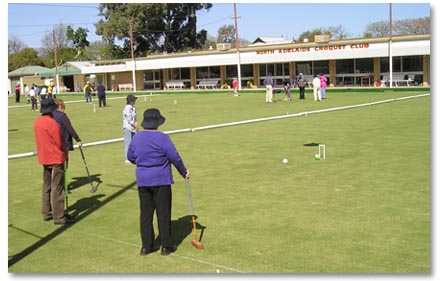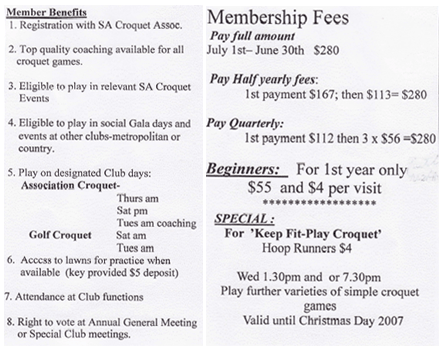

|
Back to |
| The Front Page |
| News & Features |

|
Is direct mail advertising a practical strategy for growing membership?
|
|
by Bob Alman, Founding Editor with Doug Amey and John Riches; photos by Doug Amey Posted November 17, 2007
|
Croquet as a business is mostly limited to small-scale equipment manufacturers, a few entrepreneurs who sell croquet event services to corporations, charities, and private parties; and two 12-court mega-centers whose expenses require them to generate sustaining revenues. For the most part, local amateur croquet facilities are given the same kind of free ride that tennis players and lawn bowlers enjoy by the government jurisdictions or property owners who offer croquet as a public or private amenity, and they grow mostly by word-of-mouth of existing members. Free media - newspaper articles, feature TV spots, and free newspaper event listings - helps get the word out, but experiments in paid advertising have generally failed, often miserably. But would direct-mail advertising for members work when other forms of business promotion have failed? You be the judge, after you consider the recent direct-mail promotion of the North Adelaide Croquet Club.
Australia is arguably the sportiest country in the world; and it's the most populous croquet-playing country, by any standard: In absolute numbers, there are more than 8,000 members of the Australian Croquet Association, and almost 1,000 of them live in South Australia, where Adelaide is the biggest population center. To put these numbers in perspective: In the United States, one in every 90,000 citizens belongs to the U.S. Croquet Association; in Australia, one in every 2,500 belongs to the Australian Croquet Association; as a percentage of population, club-based croquet is thirty-five times more popular in Australia than in the United States.
|
direct-response advertising |
|
As a direct marketer, I have to say the approach used by the Adelaide club would probably not work well in the UK. As one alternative, we would aim for less waste, smaller expense, and more results by delivering the leaflet along with the weekly free newspaper - which can be targeted with pinpoint accuracy.
It's too bad that the croquet target group (retired and middle class) are the least
responsive of all sections of the population. In these circumstances, a response rate of 0.5% may be regarded as impressive.
Direct marketing has one major advantage over other mechanisms in being entirely
measurable. Clubs often have no way to determine whether their free press feature has produced an effect; but a "personal" direct-mail message often prods prospects into making an immediate response via a tear-off or an invitation to phone.
- James Hawkins, co-editor, Croquet World Online
|
That's exactly what the North Adelaide Croquet Club did, quite methodically and expertly, beginning with a well-designed brochure targeted for 10,000 nearby residences through the mail - those closest to the club. According to Doug Amey, former president of the club and the coordinator of the program, it was targeted specifically for older people and retirees, although the hope was that that others would also respond.
In fact, that expectation was built into the entire program, funded by a grant to the North Adelaide Croquet Club from the state Office for the Aging, especially to promote croquet in the district. According to Amey, "The purpose as stated in the grant application was to attract people currently not involved in any physical activity - particularly new retirees, those contemplating retirement and people who have had to give up the more physically demanding sports.
"Approximately 10,500 leaflets were distributed offering a four week course on Golf Croquet, from which we got 57 acceptances," Amey says. "According to Australia Post, a one percent reply to such distributions is about average. We didn't achieve that, but given the nature of the area we're in and the low profile that croquet has, it was probably not too bad."
The course ran for four weeks in September and cost $20.00 per person. Participants received four ninety-minute lessons along with a carry bag containing information leaflets about the Club and the game, a pen, and a "bucket" hat bearing the Club logo. "Some of this was sponsored by local businesses and the Prospect City Council," Amey says, "and the hats were paid for by grant money."

|
| About fifty people paid for the four-week course on the four greens of the North Adelaide Croquet Club, shown here with the clubhouse in the background. |
Club members volunteered to come out and assist during the four-week course by being available to answer questions and offer tips in games of Golf Croquet after basic instruction in holding and swinging the mallet, hitting balls, and scoring hoops.
According to John Riches, Australia's newly appointed National Coaching Director who also does the advanced coaching in North Adelaide, which happens to be his home club, "The beginners were invited to come out to the club at any time to watch Association Croquet being played." And of course, the new members are free to play any form of the game once they join the club.
At the end of the four weeks, participants were given an option to keep playing (once a week at $4.00 per visit) for a period of three months, after which they needed to decide whether or not to join the club.

|
| North Adelaide Club President and former Australian Team member, Colin Pickering, (right) instructing course participants. |
While a four-week course of instruction helps to rapidly build the novices' confidence with the equipment and the game, it also bonds the group and integrates them socially into the club. This may be the best reason of all to engage new members in extended group instruction. They advance with a peer group, as a club within a club. They form new friendships and playing partnerships. They have a built-in answer to the question, "If I join, who will I play with?"
Two-thirds of the way through the four-week instruction period [as we go to press] the club had received 16 applications for membership from the direct-mail promotion and course. "Of the remainder about a third have decided that croquet is not for them and the rest have yet to make any decision," according to Amey.
Amey and the club are hoping to get at least 20 new members from the promotion, which would increase club membership numbers to about 70. With four greens, they figure they couldn't easily cope with many more.
|
by the Numbers |
|
|
GRANT TOTAL
EXPENDITURES
REVENUE from 20 annual memberships |
$4450
1352.58 1100.00 250.00 220.00 120.00 339.00 733.60 25.95 76.40 35.45 ____________ $ 4253.28 $5600.00
|
"But whether the state granting authority will be pleased with the result remains to be seen," Amey acknowledges. "We have to submit an evaluative report to them by June 2008."
The final evaluation of the State Office of the Aging may have significant impact in Australia, where other clubs may be waiting to apply for similar grants, but for the purposes of this article, the experiment can be judged a success. If only ten of the new members in the "class of '07" rejoin next year and the year after, the club membership base will have been strengthened for a long time to come.
What about countries whose governments are less generous with such grants? They can create alternative and less expensive - though more labor intensive - ways to accomplish the same result.
Handouts distributed in nearby neighborhoods by club members would likely generate a higher response from the personal touch.

|

|

|